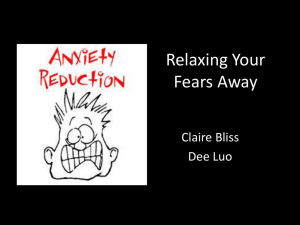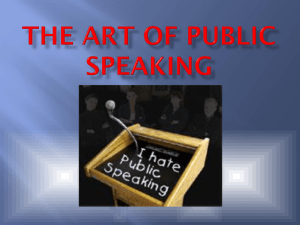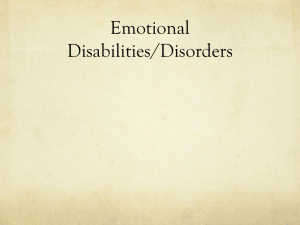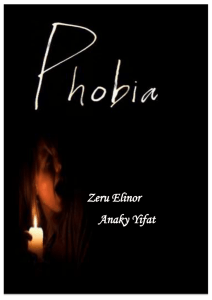Relaxing Your Fears Away-powerpoint - napsych
advertisement
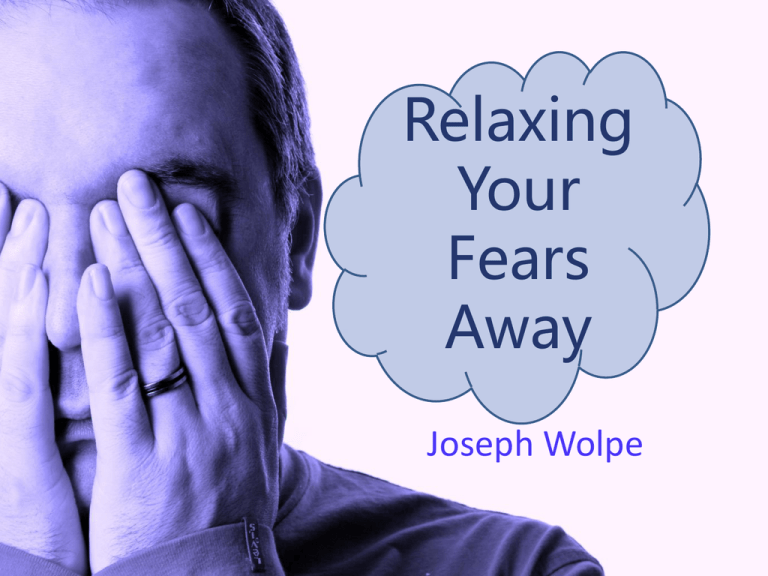
Relaxing Your Fears Away Joseph Wolpe *Phobia- an irrational fear that is out of proportion with the reality of the danger.* • Reactions include – – – – – – – dizziness heart palpitations feeling faint hyperventilation sweating trembling nausea • Three types of phobias (all treated with the same methods) 1) Simple- fear of a specific animal or situation (arachnophobia, claustrophobia, etc.) 2) Social-fear involving interaction with others 3) Agoraphobia- the fear of being in large crowds or unfamiliar places Such techniques were relatively ineffective. Wolpe’s Phobia Treatment • Behavioral therapy (classical conditioning) – the person has learned this fear so they must unlearn it! – associate relaxation with the fear • Reciprocal Inhibition -the incompatibility of the two competing responses (fear and relaxation) -anxiety inhibiting response is relaxation • Systematic desensitization -One must first be taught relaxation skills in order to extinguish fear and anxiety responses to specific phobias -Then he or she must use these skills to overcome situations in an established hierarchy of fears Such techniques were successful! You go J. Wolpe! Wolpe’s phobia treatment (applied) 1) The mouse has a fear of cats. 2) The mouse is repeatedly given cheese every time it sees a cat. 3) The mouse cannot enjoy the cheese AND be afraid of the cat at the same time. 4) So the fear response is inhibited by the feeding response. 5) The mouse is no longer afraid of cats. 1) Mrs. Failla has a fear of ventriloquist dolls. 2) She learns Wolpe’s relaxation techniques to use when she sees --> 3) Mrs. Failla cannot relax AND be afraid of the doll at the same time. 4) So the fear response is inhibited by the relaxation response. 5) Mrs. Failla is no longer afraid of ventriloquist dolls. Experimental Method Wolpe took 39 random phobia cases. First several sessions Constructing the hierarchy Climb the phobia ladder -relaxation lessons by tensing and relaxing muscles until a deep state of relaxation is achieved -develop a list of anxiety producing situations involving the phobia -using the relaxation techniques, imagine to be in the scene involving the phobia described by Wolpe CLAUSTROPHOBIA 1-Reading of miners trapped. 2-Being told of someone in jail. 3-Having a tight ring on a finger. 4-Journey by train. 5-Ride an elevator. 6-Ride an elevator with others. 7-Pass through a tunnel on a train. 8-Being locked in a room. • It took an average of 12.3 sessions to complete the phobia hierarchies. • The success of the therapy was judged by the patients’ own reports. – Rated the process as successful, partially successful, or unsuccessful. • 91% (35/39 clients) rated successful or partially successful! – leaving only 9% unsuccessful *After obtaining follow up reports from 25/35 patients who were initially rated successful, none experienced relapse, new phobias, or other neurotic symptoms.* Subsequent Research (2003) • “Math phobia” study • Wolpe’s techniques used to help students overcome extreme levels of math anxiety • Students practiced progressive muscle relaxation and were given relaxation tapes to listen to each day when they went home • Each student created an 11 stage hierarchy • It worked! • 11/12 displayed recovery or improvement in their levels of math anxiety • They even maintained the reductions in their math anxiety in a 2 month follow up A Version of the Scale Used Today (developed by Wolpe) • • • • • • • • • • • 10 = Feels unbearably bad, beside yourself, out of control as in a nervous breakdown, overwhelmed, at the end of your rope. You may feel so upset that you don't want to talk because you can't imagine how anyone could possibly understand your agitation. 9 = Feeling desperate. What most people call a 10 is actually a 9. Feeling extremely freaked out to the point that it almost feels unbearable and you are getting scared of what you might do. Feeling very, very bad, losing control of your emotions. 8 = Freaking out. The beginning of alienation. 7 = Starting to freak out, on the edge of some definitely bad feelings. You can maintain control with difficulty. 6 = Feeling bad to the point that you begin to think something ought to be done about the way you feel. 5 = Moderately upset, uncomfortable. Unpleasant feelings are still manageable with some effort. 4 = Somewhat upset to the point that you cannot easily ignore an unpleasant thought. You can handle it OK but don't feel good. 3 = Mildly upset. Worried, bothered to the point that you notice it. 2 = A little bit upset, but not noticeable unless you took care to pay attention to your feelings and then realize, "yes" there is something bothering me. 1 = No acute distress and feeling basically good. If you took special effort you might feel something unpleasant but not much. 0 = Peace, serenity, total relief. No more anxiety of any kind about any particular issue. Discovered Through Wolpe’s Study • In the 1950’s, psychoanalysis was very common and popular form of psychotherapy. • Today, thanks to Wolpe, desensitization is proven successful and shows many advantages over psychoanalysis. *Systematic desensitization has grown to the point that now it is considered the treatment of choice for anxiety disorders, especially phobias.*
